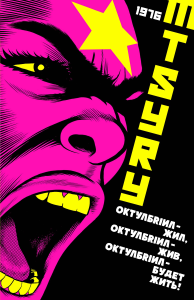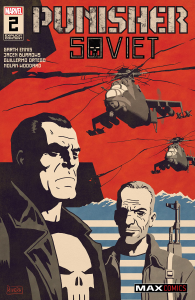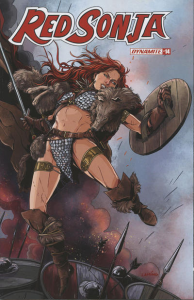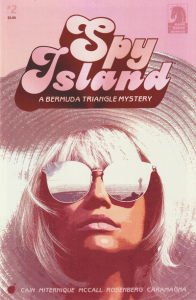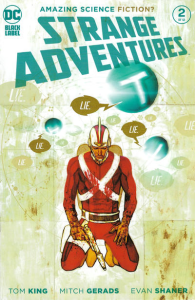If you read last weeks’ posts, you know what’s going on. Here are another five comics that came out in 2020 and feature neat takes on adventure, crime, horror, espionage, mystery, war, science fiction, and/or the occasional hero with bizarre garments:
MTSYRY OCTOBRIANA 1976
I hesitated about including a comic with less than 30 pages (and minimal plot) as ‘book of the year’ and I eventually left it out of the original list, but Mtsyry Octobriana 1976 was one of the most fun reading experiences I had in 2020. In this delirious one-shot, Jim Rugg adds to the growing myth of the Russian (anticommunist) superheroine Octobriana, an uncopyrighted character created by Czech writer Petr Sadecký during the Cold War which has been reappropriated by various creators throughout the decades (for instance, versions of Octobriana have shown up in The Adventures of Luther Arkwright and in Nikolai Dante).
You can look for political commentary in Mtsyry Octobriana, but the most political thing about this kitsch pastiche of dissident propaganda isn’t in the text itself… It’s in its punk attitude of DIY, in its revolutionary will to experiment with format, and perhaps in the notion that titillating hedonism can be a form of liberation, as the intensity of Rugg’s speed lines and cartoony explosions seems designed to elevate your endorphins to whole new levels. With the look of underground comix read through an acid trip, the whole thing boils down to an injection of action-packed exploitation, pitting a big-breasted babe with sub-machine guns against a robot version of Joseph Stalin, all rendered with Steranko-worthy visuals and the most psychedelic colors to ever grace a page (at least in my neon edition… apparently Rugg put out two other versions!). In other words: a blast.
If you’d like a more restrained Soviet-themed thriller, though, perhaps you’ll prefer the next entry…
PUNISHER: SOVIET
In this gritty yarn, the Punisher meets Valery Stepanovich, a Russian veteran on a vengeance crusade of his own, who tells Frank about his traumatic experience in the Soviet-Afghan war back in the 1980s (drawing a clear parallel with the United States’ more recent exploits in the region). They then join forces against a vicious Russian mobster. Hardcore carnage ensues.
There is nothing new about Garth Ennis writing the Punisher, much less about him writing a war comic, even if this is the first time he has delved into this specific historical conflict. There isn’t even anything particularly new about the fact that the whole thing is illustrated with tight mise-en-scène and disturbingly realistic visuals by Jacen Burrows, who has made a career out of drawing some of the most brutal action on the stands (and who had already collaborated with Ennis on 303, which also revolved around a Spetznaz officer and was initially set in Afghanistan). While nobody is attempting groundbreaking work here, though, these are still two masters of the medium doing what they do best: absurd macho bullshit.
I’m quite fond of how Ennis keeps injecting his work with personal passions and knowledge from outside the endogamic world of comics, including when writing for a franchise from a major publisher – even when they miss the mark, at least the results tend to be fascinatingly idiosyncratic. Here, as it’s often the case, the politics are intriguingly contradictory: on the one hand, an American senator’s treasonous dealings with Russia are treated as a repugnant offense; on the other, there is a sense of empathic recognition between the Punisher and Stepanovich, two soldiers sent by their respective empires to fight in the same godforsaken piece of land, as if what unites them is something much stronger than the artificial divisions of national powers. At the end of the day, in true Ennis fashion, there is nothing worse than elites callously sacrificing the grunts.
RED SONJA
Mark Russell had a pretty amazing year all around, but his run on Red Sonja takes the prize. Yes, this is another instance of a series that would’ve probably ranked high on the original Books of the Year list if it had had a 2020 collection rather than just a bunch of scattered issues. That said, this is still an awkward recommendation, since Russell himself has publicly denounced Dynamite’s links to the hate group ComicsGate and refused to carry on working for them… While I don’t support the publisher’s values or practices, though, I would be amiss if I failed to highlight one of my favorite reads in recent times.
Russell’s run started out in 2019 (that first year has been collected in the books Scorched Earth and The Queen’s Gambit) and continued throughout last year with issues #13-22 (it just wrapped up with #24), plus the mini-series Killing Red Sonja. Set in the fictional Hyborian Age (the same from Conan the Barbarian, who also recently starred in a cool run, penned by Jason Aaron), this sword & sorcery saga followed the eponymous warrior, now turned queen of Hyrkania, a piss-poor region whose population consists mostly of peasants and thieves. After the war in the previous arc, living conditions in Sonja’s land are even worse than usual, so she sets off to bargain for aid from the neighboring Kingdom of Khitai, quickly becoming embroiled in its palace politics and military campaigns (cue in a buckload of slaughters). The Killing Red Sonja spin-off – co-written by Bryce Ingman – also takes place in the war’s aftermath, but it follows the emperor of Zamora in his quest for revenge, along with a witch-cursed talking boar (the two storylines converge in Red Sonja #19).
Russell’s Red Sonja is as close-to-perfect a take on this genre as I can recall. For all the blood and thunder, the comic’s main use of its fantasy setting is as a backdrop for poignant parables about war and imperialism, with the cast often speaking in pithy aphorisms (‘Empires are tricky beasts. They make countrymen out of enemies and enemies out of countrymen.’). Plus, the whole thing is much more tasteful than what the sleazy covers may suggest. Although occasionally reverting to Red Sonja’s traditional metal bikini outfit, neither the scripts nor Bob Q’s and Craig Rousseau’s artwork prove particularly keen to sexualize the protagonist (the same can’t be said for Alessandro Miracolo’s issues, which nevertheless look lovely). In fact, much of the joy derives from watching this resourceful, empowered woman outsmart all the bastards around her – which felt particularly cathartic in 2020, as many of Sonja’s opponents were despotic rulers with little regard for their people.
(Speaking of Red Sonya kicking imperial butts, John Layman’s and Fran Strukan’s slapstick mini-series Mars Attacks Red Sonja was also a hoot!)
SPY ISLAND
Outside of The Ludocrats‘ Don-Quixote-by-way-of-Tex-Avery farce (and of the movie Freaky), some of the loudest laughs I had last year derived from reading Spy Island, Chelsea Cain’s and Lia Miternique’s rousing mini-series set in a surreal Bermuda Triangle filled with secret agents and possibly homicidal mermaids. Or, better yet, set in a blown-up version of the super-spy subgenre from the swinging sixties, where everybody was groovy and villainous megalomaniac organizations weren’t ashamed to call themselves the Brotherhood of Depravity. Also, the eponymous island may be a metaphor for Sigmund Freud’s view of the human mind.
Cain’s script extracts humor, not just from absurdist situations and snappy dialogue, but also from detours into the island’s touristic leaflets, maps, warning signs, and other artefacts from the story’s world. This approach becomes even quirkier when rendered by Elise McCall’s experimental artwork – supplemented by Martinique and Stella Greenvoss – which combines inventive page designs with odd photo collages. After their previous successful collaboration with this team in Man-Eaters, colorist Rachelle Rosenberg and letterer Joe Caramagna once again prove themselves to be the perfect partners in crime, adding to the overall bubbly spirit. Thus, refreshingly, while the plot is deliberately preposterous, this comic never ceased to surprise me with its creative choices at every turn.
STRANGE ADVENTURES
Further proof that DC’s greatest output is being churned out in limited series (rather than in the regular titles, entangled as they are in convoluted continuity and uninspired crossover events), Strange Adventures sees the team behind the acclaimed Mister Miracle now working their magic on another one of the company’s pulpiest characters, Adam Strange (an archeologist zapped across the galaxy to the planet Rann, where he became a jetpack-wearing, laser-gun-firing war hero).
Once again going for a hyper-conceptual approach, Tom King, Mitch Gerads, and Clayton Cowles – now joined by artist Evan ‘Doc’ Shaner – add layers upon layers to the material. Plot-wise, this is a murder mystery/conspiracy thriller/space adventure/war story that alternates between flashbacks to the exploits of Adam Strange and his wife Alanna during Rann’s war against the Pykkt Empire, their current PR troubles on Earth, and Mister Terrific’s investigation into both matters. Formally, each plotline is served by a different artistic style, all of them superb (both Gerads and Shaner color their own work, creating distinct atmospheres). Guest-appearances and references to other DC characters tap into readers’ awareness of this vast, interconnected universe, but so far you don’t need much prior knowledge to keep up (even when it comes to the main cast, as long you can stomach missing out a few allusions). Moreover, every issue finishes with a quote from a classic comic book creator, linking the series’ themes with the generational views that first informed the world of Adam Strange (who debuted in the original Strange Adventures anthology series, back in 1958). Besides addressing the genre’s relationship with war, colonialism, and heroism, however, the comic can also be seen as commenting, more broadly, on mainstream culture’s relationship with those issues, including the tension between the indictment of violence, the celebration of bravery, and the ‘support the troops’ mentality.
Strange Adventures ingeniously touches on all of this through a sort of channel-zapping format, quickly jumping from one plot thread to another, each panel kept simple while alluding to an elaborate reality. If comics are about imagining what takes place between panels, this series gives you just enough to imagine an entire epic looming right outside your field of vision. By evoking genre tropes and perfectly selecting key moments, it manages to convey a massive scope with very little exposition (Mark Millar tried a similar effect early on in Starlight, but it ultimately led to a cliché-ridden space yarn, while Strange Adventures takes it for granted that you can imagine such a cliché-ridden space yarn by yourself).
Only seven (out of a planned twelve) issues came out in 2020 and they haven’t been collected yet, but Strange Adventures will probably make it to Book of the Year next time around, since it just keeps getting better and better. The second issue leaned too heavily on the gimmick of Mister Terrific being constantly tested by his floating robotic spheres, especially because the questions didn’t really test his intelligence so much as his encyclopedic memory of facts and quotes (for a cleverer take on this gimmick, check out another great conceptual sci-fi comic, East of West, which wrapped up last year), but soon we got to see more awesomely ridiculous uses of Terrific’s super-intellect (he quickly teaches himself an entire alien language!). Moreover, while the elliptical storytelling created a powerful sense of pace and scale early on, it could’ve run thin if extended to a full series, so issues #3 and #5 lingered a bit longer on specific sequences from the Rann-Pykkt war. It therefore felt like we were finally gaining deeper access into a reality that we had mostly – and loosely – imagined so far… a process that in some ways mirrors the experience of many of us regarding our own world, as we keep uncovering the true atrocities that took place on the ground the deeper we dig into current and past conflicts abroad.

